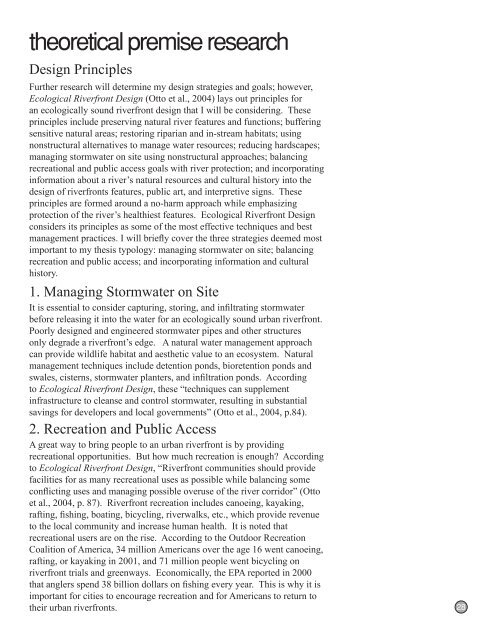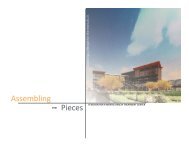Aaron Hanson Thesis Book.pdf - NDSU - North Dakota State ...
Aaron Hanson Thesis Book.pdf - NDSU - North Dakota State ...
Aaron Hanson Thesis Book.pdf - NDSU - North Dakota State ...
You also want an ePaper? Increase the reach of your titles
YUMPU automatically turns print PDFs into web optimized ePapers that Google loves.
theoretical premise researchDesign PrinciplesFurther research will determine my design strategies and goals; however,Ecological Riverfront Design (Otto et al., 2004) lays out principles foran ecologically sound riverfront design that I will be considering. Theseprinciples include preserving natural river features and functions; bufferingsensitive natural areas; restoring riparian and in-stream habitats; usingnonstructural alternatives to manage water resources; reducing hardscapes;managing stormwater on site using nonstructural approaches; balancingrecreational and public access goals with river protection; and incorporatinginformation about a river’s natural resources and cultural history into thedesign of riverfronts features, public art, and interpretive signs. Theseprinciples are formed around a no-harm approach while emphasizingprotection of the river’s healthiest features. Ecological Riverfront Designconsiders its principles as some of the most effective techniques and bestmanagement practices. I will briefly cover the three strategies deemed mostimportant to my thesis typology: managing stormwater on site; balancingrecreation and public access; and incorporating information and culturalhistory.1. Managing Stormwater on SiteIt is essential to consider capturing, storing, and infiltrating stormwaterbefore releasing it into the water for an ecologically sound urban riverfront.Poorly designed and engineered stormwater pipes and other structuresonly degrade a riverfront’s edge. A natural water management approachcan provide wildlife habitat and aesthetic value to an ecosystem. Naturalmanagement techniques include detention ponds, bioretention ponds andswales, cisterns, stormwater planters, and infiltration ponds. Accordingto Ecological Riverfront Design, these “techniques can supplementinfrastructure to cleanse and control stormwater, resulting in substantialsavings for developers and local governments” (Otto et al., 2004, p.84).2. Recreation and Public AccessA great way to bring people to an urban riverfront is by providingrecreational opportunities. But how much recreation is enough? Accordingto Ecological Riverfront Design, “Riverfront communities should providefacilities for as many recreational uses as possible while balancing someconflicting uses and managing possible overuse of the river corridor” (Ottoet al., 2004, p. 87). Riverfront recreation includes canoeing, kayaking,rafting, fishing, boating, bicycling, riverwalks, etc., which provide revenueto the local community and increase human health. It is noted thatrecreational users are on the rise. According to the Outdoor RecreationCoalition of America, 34 million Americans over the age 16 went canoeing,rafting, or kayaking in 2001, and 71 million people went bicycling onriverfront trials and greenways. Economically, the EPA reported in 2000that anglers spend 38 billion dollars on fishing every year. This is why it isimportant for cities to encourage recreation and for Americans to return totheir urban riverfronts.28





